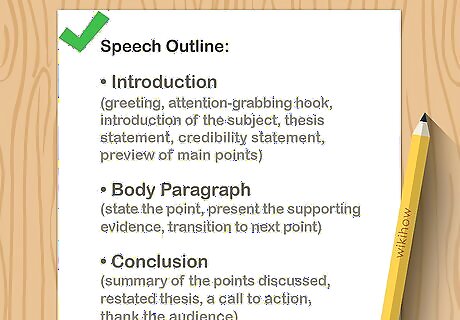
views
Chunking Your Speech

Write out the entire speech and read it out loud. To cement the speech in your head, you need to write it out in its complete form. This includes the introduction, body, and conclusion of the speech. Reading the speech aloud will also allow you to hear how it sounds thematically, as well as keep more of your senses engaged in the memorization process. You should write out the entire speech even if you do not plan on memorizing it verbatim. The point is not to memorize it right now, but to get a sense of how the speech reads and flows. If at all possible, try to read the speech in the place you will deliver it. The acoustics of every room and setting vary somewhat, so reading your speech in the actual delivery location can help you get accustomed to the way your voice will sound from that spot. Additionally, it helps you get comfortable with the layout of the room, making it possible for you to rehearse your movements as well as your words.

Split the speech into short chunks that are 2-3 sentences long. The chunks can be sentences that are on the same topic or they can be organized based on how difficult they are for you to remember. The goal should be for you to know which parts of the speech you need to work on memorizing the most. Take the time to actually mark off each section or chunk of information in your written notes. This can make it easier for you to recall when one part ended and when the next part picks up as you practice, making it harder for you to accidentally forget or leave any parts out.

Practice the first chunk of your speech until you can fully recall it. Practice reciting this first chunk of information out loud while referring to your notes as little as possible. Once you're able to recite the entire chunk without having to look at your notes at all, consider this chunk memorized. If you get stuck, do not immediately return to your notes. Start from the beginning and try to say the chunk again. If this fails, spend a few more moments trying to recall the missing information. When you decide that nothing can help you remember it, return to your notes and briefly look up what the missing part consisted of. When you finish memorizing a chunk of your speech, read through it again to verify that you have it correct.

Add more and more chunks to your recall. Once you finish recalling the first chunk successfully, add a second chunk to it, repeating both until the second chunk can be recited from memory, as well. Be sure to memorize chunks that appear sequentially in your speech, since this is the order that you'll have to recall them in later on. It is important that you continue repeating previously memorize chunks so that you do not forget them. Moreover, repeating all chunks of your speech together will help you to memorize how each chunk fits together with the rest.

Continue this process until you've memorized the whole speech. Continue practicing your speech out loud without looking at your notes. If you have trouble remembering a certain chunk, isolate it and focus on recalling it from memory before trying to weave it back into the speech as a whole. Regardless of which memorization tactics you use and how effective they are, the most valuable thing you can do for yourself is to practice the speech as often as possible. Practice your speech from memory as best as possible. You can refer to your notes when you get stuck but deliver as much as possible without your notes. Try to practice your speech from memory for at least half of your practices, if not more.
Using the Visualization Technique

Write an outline of the speech using bullet points instead of sentences. This type of outline will touch on all the major parts of your speech, making it easier for you to divide it into manageable parts. Use bullet points that describe the main themes of each section of your speech, as well as any smaller themes or points within these sections. For instance, instead of writing “When I was a child, I was attacked by a dog. It was a mean old dog that belonged to my neighbor at the time. Ever since then, I've been afraid of dogs,” simply write “dog attack story.” Writing your outline this way will prevent you from memorizing the exact words you intend to use in your speech, which would make you sound robotic instead of natural. Your outline should include all major ideas and all major supporting ideas. If you have any special examples or analogies you want to use within your speech, these also warrant bullet points.

Divide the speech into distinct sections based on your outline. Each main idea or major supporting detail that was written as a bullet point in your outline should be considered a distinct section. If you have multiple bullet points that are very similar to each other, these can also be lumped together into a single section. For example, if 1 bullet point reads “my semester abroad in China” and the next bullet reads “attending a Chinese school,” these can be combined into a single section called “my experiences in China.” These sections should logically flow into each other in a comfortable narrative format. Think of them as the different acts in a story you're telling the audience. If you did not write an outline or do not like the way your information is organized into bullet points on the outline, you could opt to divide your speech by paragraph instead of by bullet point. The idea is mostly to assign one major idea to each part.

Visualize a mental image for each section of your speech. Choose an image that is related to the theme of the speech section, but which is also a little bit odd or off the wall. The more absurd and unique the image is, the easier it will be to recall it later. For instance, if a part of your speech mentions that coconut oil can help hair grow faster, you could imagine something like Rapunzel sitting on top of a tower made of coconuts or living in a room filled with coconuts. Rapunzel emphasizes the idea of long hair, while the coconuts help point out the connection to coconut oil.

Assign each of these images a location in your home. Pick out areas of your home, such as the kitchen sink, your work desk, or the top of the coffee table, and match these areas to the sections of your speech. They don't necessarily have to be related to the theme of the speech section; each section just needs to be attached to a location. For example, the section of your speech on your experiences abroad can be assigned to your bathroom sink if you like. You can choose another location besides your home if you like, such as your office or the road you drive on to get to work. The location can be near or far; the choice is up to you. Ultimately, though, you should be able to navigate it well enough in your mind to find your way to your various visuals. Alternatively, you could also use the human body as a map. The images can be “tattooed” onto the body in your mind, and as you travel along the body, you will hit the images in order more naturally.

Practice linking the visuals together to recall your speech. With the locations and visualizations set, you need to begin practicing your speech by relying on these visuals for guidance. As you practice, actually imagine yourself traveling from location to location, viewing each image in the order that its corresponding bullet point falls within your speech. Construct narrative links between each mental image. For example, if your visual for the dog attack story was a bandaid and your visual for your experiences in China was a dumpling, imagine yourself putting a bandaid on in the bathroom, then walking into the kitchen to find a dumpling on the counter. You need to have firm links connecting one visualization to the next. If not, you might forget the order your information is supposed to land in.
Employing Other Methods

Record yourself reciting the speech, if possible. While writing and speaking your speech are the 2 most important practices involved in memorizing the speech, recording the speech and playing it back for yourself can also help. This also gives you a chance to see how you actually look and sound when reciting your speech, which is also important! Use this recording to listen to your speech when you do not have the chance to practice it out loud. You can play it for yourself in the car or play it as you fall asleep, for example.

Engage your other senses as much as you can. If certain keywords bring to mind particular sounds, smells, tastes, or touches, weave those imagined sensations into the visualization process or recall of your speech. Mental images are often the strongest sense to rely on for memory, but these other senses can still help significantly. For instance, if you say that a certain historical event really made a bang or made a splash, you can imagine the sound of a loud bang or the sound and feeling of something heavy dropping into water.

Create an acronym if your speech includes a list. An acronym uses the first letter of each item in the list to create a sentence or word, which can then be used to recall those first letters. The sentence or word doesn't have to be thematically related to the list, so long as you remember it! For example, you can use the acronym HOMES to recall the names of the Great Lakes in the U.S., H for Huron, O for Ontario, M for Michigan, E for Erie, and S for Superior.




















Comments
0 comment